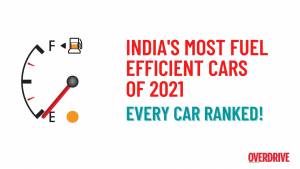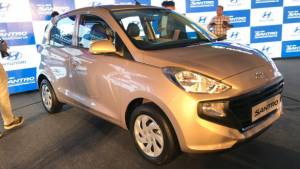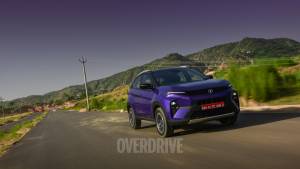Comparison test: Hyundai Santro AMT vs Maruti Suzuki Celerio AMT vs Tata Tiago AMT
The Santro is the car that introduced the Indian market to a new and unknown Korean car maker - Hyundai. Fast forward 20 years and Hyundai is India's second largest auto brand. So, with the new Santro, things should be easier for Hyundai, right? Well, it does have its work cut out for it, in the form of the two best-sellers in the segment the Maruti Suzuki Celerio, and the 'big' small car, the Tata Tiago. To make things more compelling, all three have Automated Manual Transmissions available for not much more than their manual counterparts.The question is then, does the new Santro rest on its legacy, or is it a genuinely good car?
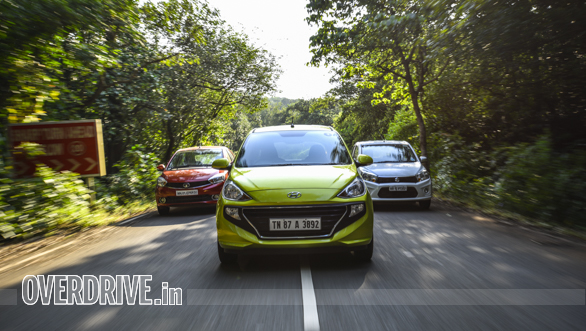
Looks
Like the original, the new Santro is youthful and quirky and very polarizing. Though, for the most part, it resembles the car it is meant to replace the original i10, more than the old Santro. Hyundai says the new grille is meant to look like a smile, and if you're familiar with manga at all, you'll see the toothy, full-face grin too! The boomerang-shaped creases along with the very unique dropping window line do help distinguish an otherwise safe profile, but I can't help but get the feeling those lines were an afterthought.

The Celerio is a handsome car when seen on its own, possibly the most masculine of the lot with its straight lines and serious-looking face. However, the moment you see it out on the road, it's lost. Worse, it's easily mistaken for its smaller sibling, the Alto. Though it's the smallest of the three in terms of length, it boasts the longest wheelbase at 2,425mm.
That's more than Tata's Tiago, though it is the longest and widest car here. But as a result, the Tiago has the best proportions, with a long hood, short overhangs, and minimal gaps between the wheels and arches making for a great stance.
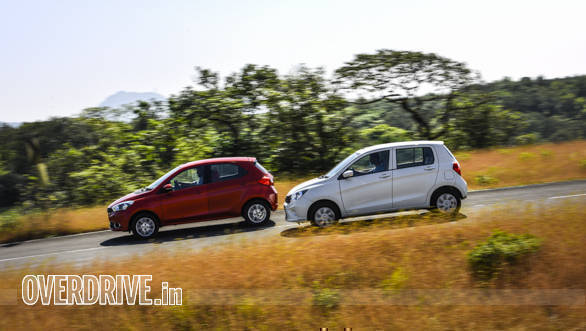
The Santro, Celerio and Tiago all ride on 14-inch wheels, but the Tiago is the only car here to get alloy wheels. It's the hatch I would pick if I had to go purely on looks alone, but that's not how this works, right?
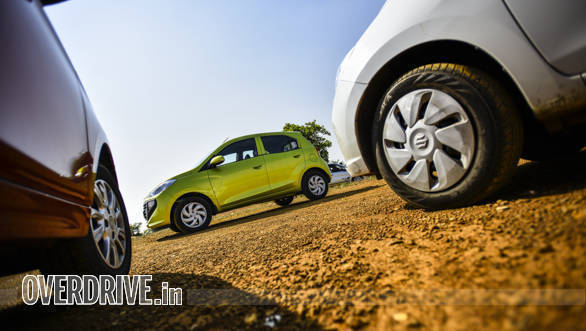
Interiors and features
When you seat yourself in the Santro's cabin, it's natural to assume it's a more expensive car. The cabin feels super premium, in part thanks to the seven-inch touchscreen infotainment. Call us suckers for colour-coded interiors, but the superbly executed contrast double-stitching on the upholstery and green seat belts wouldn't be out of place on a sportscar! For Hyundai to then slap a black logo on the steering, instead of chrome, feels like a step backward. The Apple/Android connectivity, touchscreen infotainment, and rear AC vents themselves could help seal the deal, given that the Santro is the only car that gets them! Strange (cost-cutting?) omissions are the lack of a wash/wipe feature for the wipers, and lane-change indicators. It's also the only car here that doesn't offer adjustment in either seat height or steering rake, but the driving position is commanding, if not a little high up for me personally.

The Celerio feels familiar and comfortable, with a low seating position. The dual-tone interiors do great things for the impression of space except it's lighter in the contact points and thus shows dirt more easily. The Celerio is the only one here to get an exterior boot release handle, which is extremely convenient.
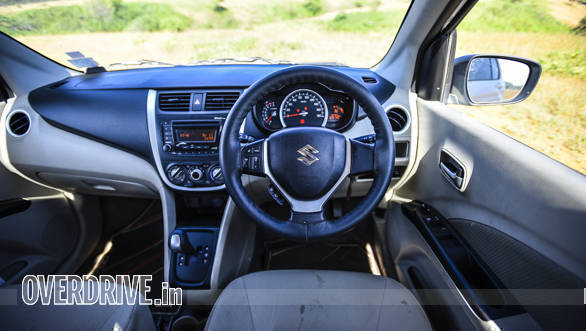
An interesting mix of textured plastics and gloss black surfaces stands out in the Tiago, but nothing feels as premium as it looks, and the little tabs on the AC vents seem like they'd break easily. Though, the headliner material stands out for being the most plush we've felt this side of a Rs 20 lakh car! Shockingly, the front door pockets are too slim to fit even 1-litre bottles, and there's no space for them in the centre stack either! It gets adjustment for the driver's seat and steering, but the driving position feels just a little off no matter where either is set.
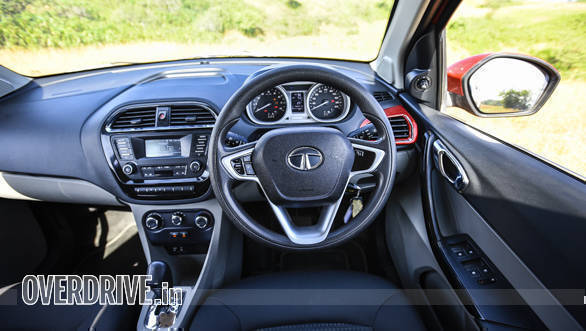
Can the story be decided from the rear bench? While the Santro feels the roomiest for three people, the Tiago's better headroom and neck support will make it more comfortable on a long drive, while the Celerio feels cramped. But still, if I had to pick one cabin to spend the next three to five years in, it'd be the Santro's for its above average noise insulation and finish. The Tiago does have the largest boot at 242 litres, even if only marginally more than the 235 litres of both the others, it's deeper and can hold more luggage in a pinch.
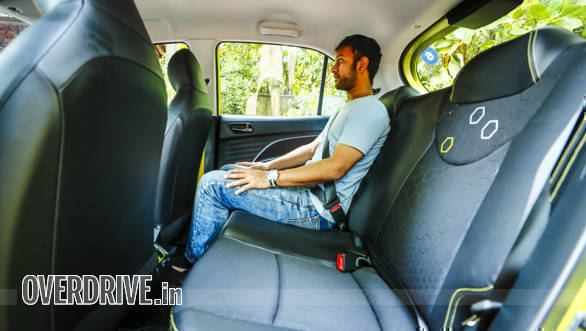
Safety
Surprisingly, the Hyundai Santro only offers a driver's side airbag in the AMT variant, while the other two offer two airbags on the top-end variants. The Tiago scores higher both in comfort and safety in being the only car to offer adjustable headrests, and speed sensing door locks.
Engine, performance and efficiency
If you were to start up all three cars side-by-side, it'd be easy to spot the four-cylinder engine in the group the Hyundai Santro. It's a very silent running 1,086cc engine with three valves per cylinder, and with 69PS of power and 99Nm of torque. There's zero judder when taking off, thanks to Hyundai's own AMT gearbox, which uses electronic actuators. Except for a slight hesitation from first to second, it shifts with the fluidity, ease and speed that you'd expect from a traditional automatic. Hands down, it's the best powertrain here.

Its performance figures suggest the same, being the quickest to crack the ton in 16.3s, as compared to the Celerio at 17.1s and the Tiago at 16.8s. It's only past 4,000rpm that the engine makes itself heard but in most cases, the mid-range is strong enough that you've already shifted up around 3,000rpm in the city to stay ahead of traffic. The great thing is that the gearbox can downshift multiple gears at once, and will do so quickly.
The Celerio sounds fairly refined for a three-cylinder engine. Its 998cc mill has four valves per cylinder and 68PS and 90Nm of torque, making it the least powerful on paper. But it does like to be revved out and even if it starts to sound strained, it's a nice, raspy note. Annoyingly, the gearbox is easily confused by even minor throttle variations.
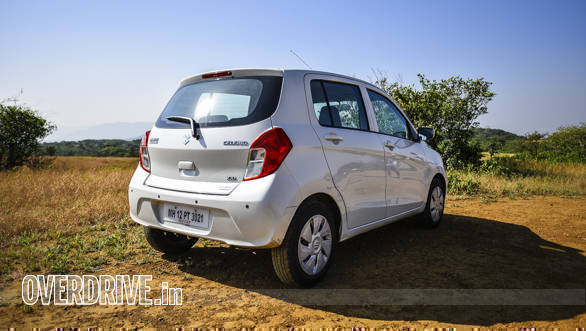
Another three-cylinder motor, the Tiago's has the most impressive specs with its 1,199cc squeezing out 85Ps and 114Nm torque. It uses a five-speed AMT too, a similar unit to the one in the Celerio, in fact. What extra judder it had taking off from standstill, it made up in shifting more predictably than the Celerio.
And now for the part most people will be interested in the fuel efficiency. While all three AMT gearboxes will shift up as early as they can to aid fuel efficiency, the Tiago is the most relaxed at 100kmph. As expected, the Maruti Suzuki Celerio is the most fuel efficient by virtue of it weighing the least, at just 850kg kerb. The Tiago surpises by being the second most fuel efficient, while the Santro surprises the most, by being the least frugal.
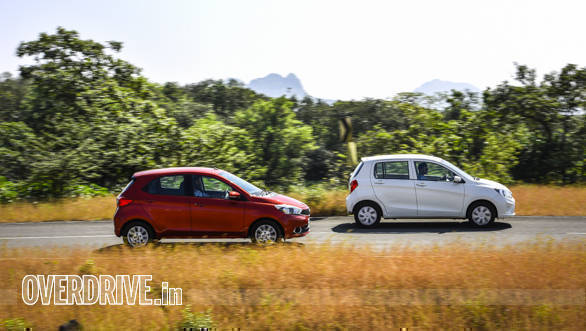
Ride and handling
The Tiago used to be the best riding hatchback, with a suspension setup that would let you barrel down the worst roads at comfortable speeds, without rattling your teeth. But now with the Santro, we have a new leader! The little Hyundai, with its noticeably more plush damping, has very good composure over all kinds of roads. Jumping out of the Santro and into the Celerio can be very revealing, with the Celerio showing a tendency to follow dips and ridges, apart from crashing over sharp edges.
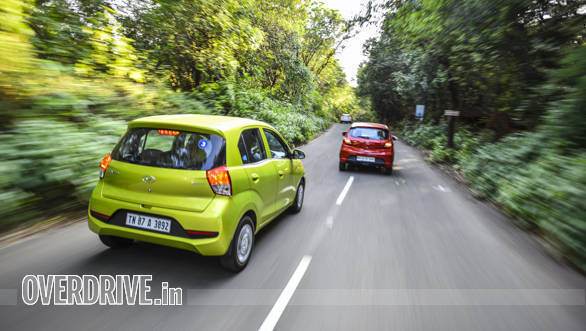
On the flip side, the Celerio has the most fun feeling chassis and steering. It turns into a corner more than willingly, even if it is a little too 'alive' on a highway. The Santro has a super light steering, which most people would appreciate at city speeds, but find a little hard to keep compensating for at higher speeds. The Tiago's steering is the most vague at centre, but once loaded up feels stable. At high cruising speeds, the Tiago feels the most stable by quite a long way. It also feels the most stable under high-speed braking, though it suffers from a spongy-feeling pedal, which kind of evens out the braking scores compared to the other two.
Verdict
It's not unusual for the newest car in a comparo to have learnt a few things along the way, and thus, have a natural advantage but it's the level of polish that the new Hyundai Santro brings to the segment that sets it apart. Sure, from the outset, the Tata Tiago is the only car here that'll have me even think of glancing back at it as I walk away, but I'm sure the novelty (sorry, Celerio) of the Santro will attract its own set of customers. A pleasant surprise for the first-time car buyer, or even the second, or third, will be the levels of finish inside the Santro for a car of this segment it also adds segment-firsts like the touchscreen infotainment and rear AC vents. If those things don't figure high on your list of priorities, the Tiago offers pretty much everything else but doesn't feel as good. In this company, the Celerio's cabin feels really far behind. And it's a similar story when it comes to NVH and ride quality. In those two areas, the Santro is ahead of the two. Even in the way the engine and gearbox perform, it's the one you have to make the least compromises for meaning you don't have to learn how to get the best out of it, something the other two AMTs ask for. As far as value goes, the introductory pricing of the Santro means it's essentially the same price as the Celerio, which is bad news for the Maruti. The little Hyundai, in its Sportz AMT spec, is also cheaper than the fully-loaded Tiago AMT! The only thing that comes close to a deal breaker is lower than par fuel efficiency. Well, you can't have everything, but you can get close with the Santro.

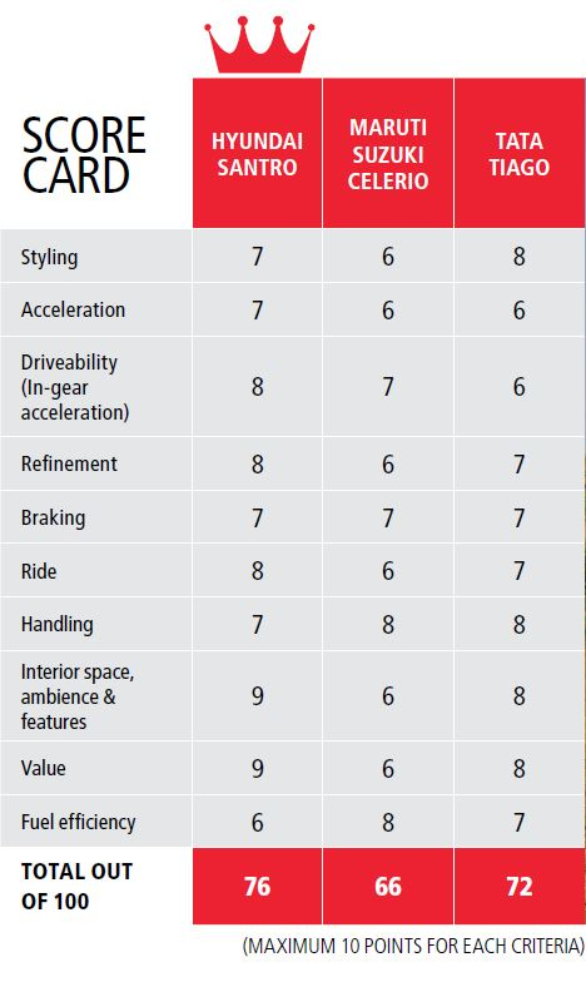
Also see: Hyundai Santro v Tata Tiago v Maruti Suzuki Celerio Video
Starts Rs 4.6 Lakhs
1199cc
Automatic
-NA-
113
-NA-
Starts Rs 3.9 Lakhs
1086cc
Manual
59
84.33
-NA-
Starts Rs 4.99 Lakhs
998cc
Automatic
67
89
26 Kmpl
-NA-
1591cc
Manual
-NA-
154
17.01 Kmpl
